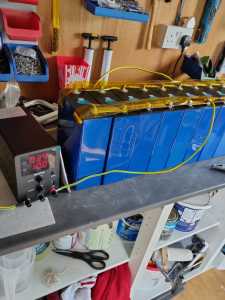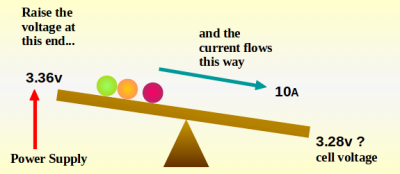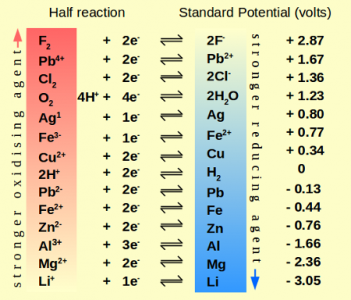I wonder if I should change my advice on top-balancing.
Should I recommend connecting the cells to the power-supply via an external/visible fuse?
To keep resistance low it would need to be a fuse in a holder with relatively large connection posts. And preferably the fuse itself should be bolted in place - not merely clipped into the holder.
Save energy... recycle electrons!
I don't think it matters too much. As long as they can charge it doesn't really matter. I'm not sure who is in a major rush. I just wasn't thinking when I connected the wires.
1. Is the power supply genuinely capable of delivering 10A? Or is it possibly a broad allusion to 10A, based on the rating of the components used inside?
2.Is the current measurement accurate? Check with an external multimeter,
3. I must emphasise - the quality of connections is extremely important. All wires need to be tightened onto terminals. Thus if you were to use crocodile clips to attach the power supply to the battery busbars, then you see a dramatic reduction in current. Tarnished copper also presents a higher resistance - ensure it's clean!
Save energy... recycle electrons!
Annoyingly I can't measure the current. I have two multimeters, one only measures AC current and the other measures DC but only on mA and doesn't have a suitable setting for that measurement. It does have a current adjustment, but I don't think I can use it as it's voltage controlled Vs current controlled. It's still charging and the voltage on the cells is increasing, it's just a slow game at the moment. My case isn't here, so no rush (yet)
Made some new connectors using left over wire connectors and some very thick cable. Now charging at 10a continuous current, aiming for 3.6v
Let's see how we get on!
@transparent by my calcs I have roughly another 29 hours of charging left to top balance.
Cells are currently at 3.36v, so 16 cells x 280ah = 15,053w of power stored currently
Desired state is 3.6v so that is 16,128w target
Its charging at 3.6v and 10amps = 36 watts per hour
(16128 - 15053) / 36 = 29.87 hours
Do I assume that you're reading that 3.36v from the meter on front of the psu?
That's not the cell voltage. The PSU voltage reading is defined such that it causes 10A to flow into the cells.
Based on the approximate State of Charge (SoC) of the EVE cells I've received from China this year, I'll predict the time taken for your cells to reach 3.6v is more like 15-18 days. 🙂
Background information for others who come across this topic later:
Lithium cells are not charged by the manufacturer before sale.
A typical post-assembly electrical test in the factory would include measurement of the internal resistance and the ability of each cell to receive a charge current of around 2C for about a minute. C is the Ah rating of the cell. So a 280Ah cell would be tested at 2 x 280 = 560A
The voltage of the cell is dictated by its chemistry, according to the universal electro-chemical series:
In our case, the Lithium Ferrous Phosphate (LiFePO4) is the cathode, whilst the anode is graphite (carbon) with a metallic backing. If you put those two materials together as thin films on a laboratory bench with an electrolyte liquid between them, electrons will flow, and you can measure a potential difference of 3.2v - which tells you nothing about the amount of charge held by those two plates.
A manufacturer will develop a method of assembly which gives them a predictable cell capacity. Thus EVE have designed a manufacturing process which yields cells of around 280-290Ah capacity. They then offer those for sale with a 280Ah specification.
The only way to find out the actual capacity of a cell you've bought is to charge it fully (to around 3.65v) and then discharge it at a current less than C to about 2.8v. (Outside those voltages risks damaging the cell).
You then verify that capacity by charging it back up again, which will obviously take a slightly greater amount of electricity due to internal losses.
If you intend doing capacity tests on cells more than a couple of times, then consider investing in a proper Capacity Load-tester. This takes a constant-current through a heating element whilst measuring the discharge characteristics. The data is streamed to a PC via a USB lead, enabling you to see the resulting graph.
Save energy... recycle electrons!
So are you measuring that voltage with the cells still charging?
Even if the PSU is disconnected, you will need to allow the cells to 'rest' for about 20 mins, and then connect a small load. You need something drawing between 1-10A. That will then allow you to obtain a reasonable measurement of the real cell voltage.
Save energy... recycle electrons!
- 26 Forums
- 2,158 Topics
- 47.4 K Posts
- 21 Online
- 5,736 Members
Join Us!
Podcast Picks
Latest Posts
-
RE: COP is not the only measure of efficiency
@toodles Your use case is indeed very different to mine...
By jamespetts , 17 minutes ago
-
RE: Anyone still weathering it out with Agile?
@toodles I guess it all comes down to import averages. ...
By Tim441 , 42 minutes ago
-
RE: Who’s Caved and Switched the Heating On Already?
Hell no, October as a matter of principle. If I had my ...
By Old_Scientist , 43 minutes ago
-

RE: Renewables & Heat Pumps in the News
@mike-patrick Well, if Europe is stalling partly due to...
By Toodles , 50 minutes ago
-

RE: Buffers, hot water and cooling
Seems a lot of work with hit or miss results and potent...
By dgclimatecontrol , 2 hours ago
-

RE: Mitsubishi Ecodan 11kw Defrosting Issue.
@dgclimatecontrol I have no intention of removing the...
By Morgan , 2 hours ago
-

RE: 300 Liter Tank - Do I have to heat it all?
The size of DHW tank affects the anti-legionella cycle....
By Transparent , 2 hours ago
-
RE: Heat Pump SCOPs – The Truth Might Not Be What You Think
@scalextrix Name plate capacity
By HCas , 5 hours ago
-
RE: Solar Thermal DHW and ASHP
I was originally contemplating a solar thermal installa...
By jamespetts , 5 hours ago
-
RE: Solar Power Output – Let’s Compare Generation Figures
My system installed in July 2024 has produced 6.4mWh in...
By jamespetts , 6 hours ago
-
RE: Vaillant aroTherm Plus 10kW thoughts?
Good unit. And the 10 kW is the same as the 12 kW I ...
By HCas , 1 day ago
-

RE: A Customer's Lessons Learnt from a Heat Pump Installation in a Large House
@judith thanks for your suggestions. Starting from col...
By GrahamF , 1 day ago
-
RE: Inventor (Midea) Heat Pump short cycling advice
I switched to "fan coil mode" to be able to set water t...
By immunity , 1 day ago
-
RE: DESNZ doing a survey which asks the right questions!
Without a survey their only source of data is probably ...
By JamesPa , 1 day ago
-
RE: Can you help with our research: solar panels, EV chargers, home batteries, heat pumps?
Just done your survey!
By Judith , 2 days ago
-
RE: Failing heat pump system - seeking thoughts on a rebuild
@cleardene-ashp just thinking about your issues here. Y...
By Judith , 2 days ago
-
RE: Midea ASHP – how to set weather compensation
@cathoderay OK let's wait and see, it sounds an interes...
By Tasos , 2 days ago
-

RE: What is the Heat Geek Guarantee?
@judith, I’m with you on Heat Geek, but there really do...
By Mars , 2 days ago
-
RE: Electricity price predictions
Community energy installations are a great idea, but th...
By Scalextrix , 3 days ago








